Search Result
Results for "
antimicrobial effects
" in MedChemExpress (MCE) Product Catalog:
1
Biochemical Assay Reagents
3
Isotope-Labeled Compounds
| Cat. No. |
Product Name |
Target |
Research Areas |
Chemical Structure |
-
- HY-121362
-
|
|
Bacterial
Endogenous Metabolite
|
Inflammation/Immunology
|
|
Evernic Acid is a secondary metabolite generated by lichens, including Ramalina, Evernia, and Hypogymnia, and several studies have described its anticancer, antifungal, and antimicrobial effects. Neuroprotective and anti-inflammatory effects .
|
-
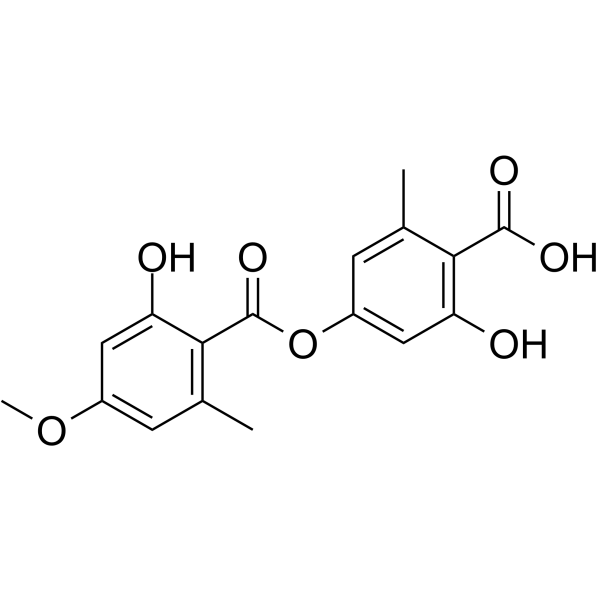
-
- HY-105008
-
|
(S,S)-SDG; (S,S)-LGM2605
|
Others
|
Cardiovascular Disease
Neurological Disease
Inflammation/Immunology
|
|
Secoisolariciresinol diglucoside ((S,S)-SDG), the main lignan in wholegrain flaxseed, is known for its beneficial effects including anti-inflammatory, antioxidant, anti-mutagenic, anti-microbial, anti-obesity, hypolipidemic, and neuroprotective effects .
|
-
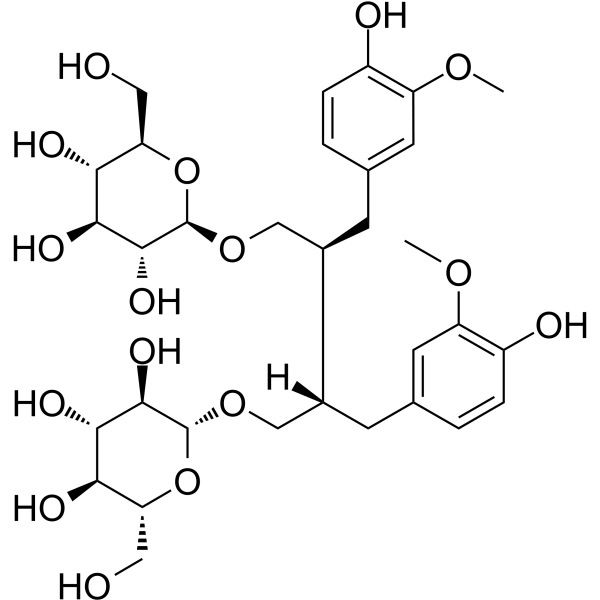
-
- HY-N0570
-
-
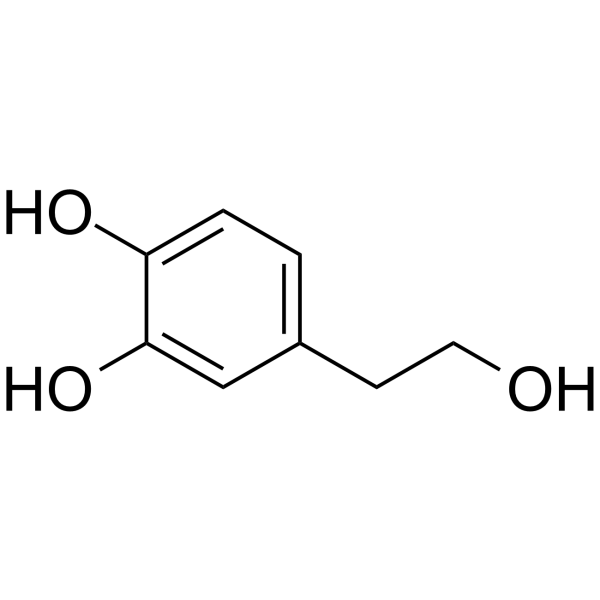
-
- HY-105061
-
|
Ro 7-0582; SR 1354
|
Bacterial
Parasite
|
Infection
Cancer
|
|
Misonidazole (Ro 7-0582; SR 1354) is a hypoxic tumor cell radiosensitizer . Misonidazole also has antimicrobial effects .
|
-
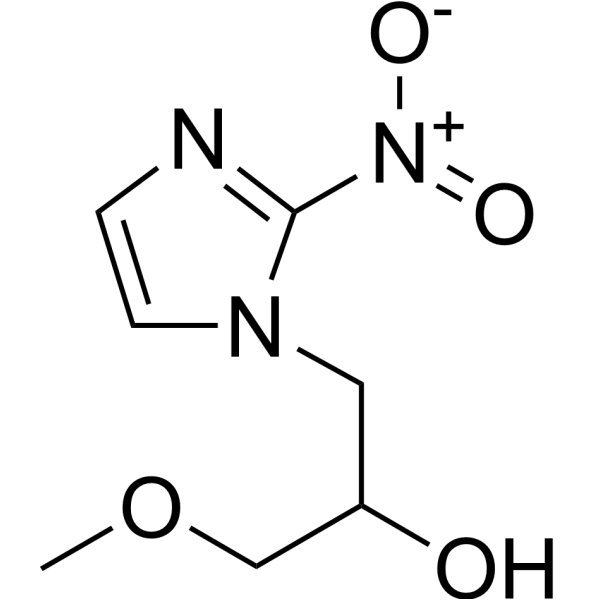
-
- HY-N3954
-
|
Glutin-5-en-3β-O-acetate; Glutinol acetate
|
Others
|
Others
|
|
Glutinyl acetate is a triterpene that can be extracted from Dorstenia arifolia. Triterpenes are reported to exhibit anti-inflammatory, antimicrobial, antiviral, cytotoxic and cardiovascular effects .
|
-

-
- HY-N0570S1
-
|
DOPET-d5; 3,4-Dihydroxyphenethyl alcohol-d5; 3-Hydroxytyrosol-d5
|
Endogenous Metabolite
Bacterial
Fungal
|
Infection
Inflammation/Immunology
Cancer
|
|
Hydroxytyrosol-d5 is the deuterium labeled Hydroxytyrosol. Hydroxytyrosol (DOPET) is a phenolic compound drawn from the olive tree and its leaves with anti-oxidant, anti-atherogenic, anti-thrombotic, antimicrobial, anti-inflammatory and anti-tumour effects[1][2].
|
-
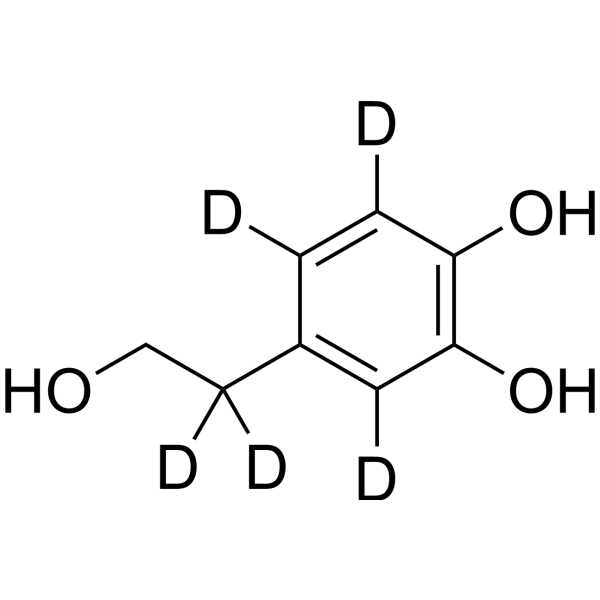
-
- HY-N0570S
-
-
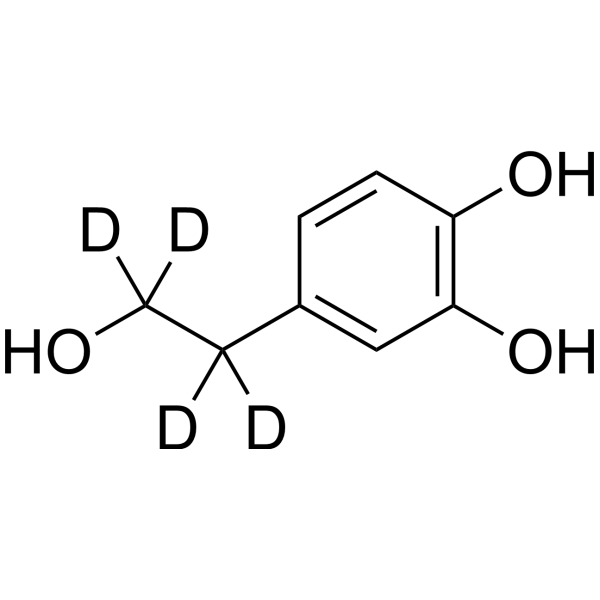
-
- HY-B0972
-
|
|
Bacterial
|
Inflammation/Immunology
|
|
Cinchophen is a potent and orally active non-steroidal anti-inflammatory agent, has analgesic and antimicrobial effects. Cinchophen can be used for the research of arthritis and some liver diseases .
|
-

-
- HY-133951
-
|
|
Bacterial
Fungal
|
Infection
|
|
4',6,7-Trimethoxyisoflavone is an isoflavone with antimicrobial activities against a wide range of bacteria and fungi. 4',6,7-Trimethoxyisoflavone also has antioxidant effects .
|
-
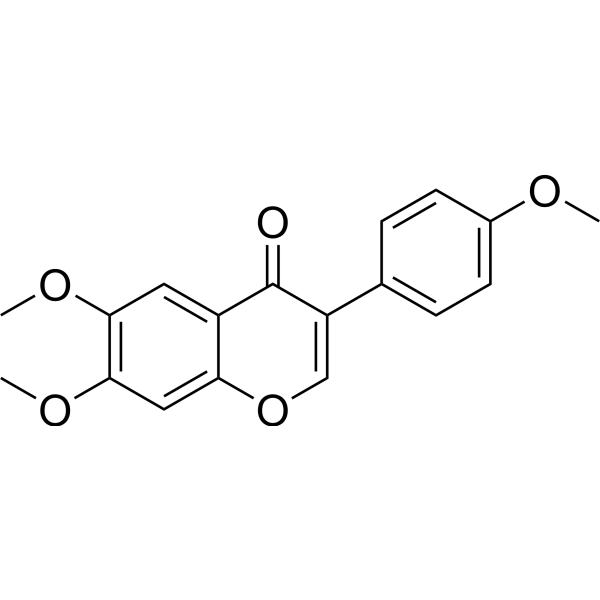
-
- HY-Y0739
-
|
|
Bacterial
|
Infection
|
|
(1R)-α-Pinene is a volatile monoterpene with antimicrobial activities. (1R)-α-Pinene reduces Bacillus cereus population growth, and exhibits repellent effects .
|
-
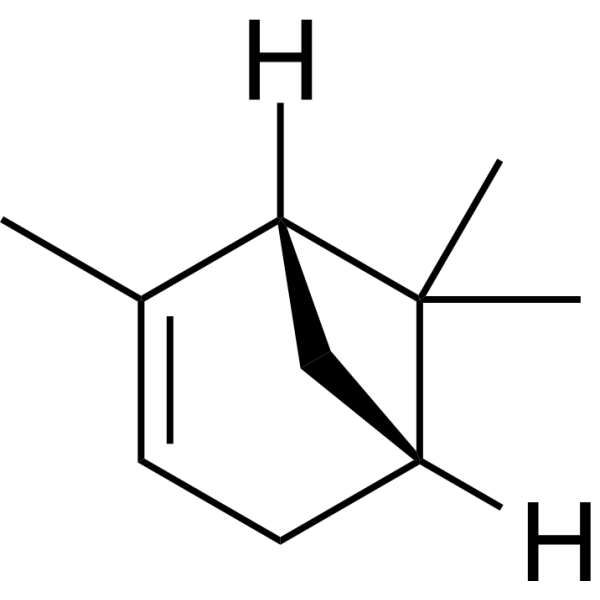
-
- HY-N9096
-
|
|
Others
|
Neurological Disease
|
|
Gentiside B has neuritogenic activity and induce neurite outgrowth. Gentiside B can be isolated from the root and rhizome of Gentiana rigescens. Gentiana has hepatoprotective, anti-inflammatory, analgesic, antiproliferative and antimicrobial effects .
|
-
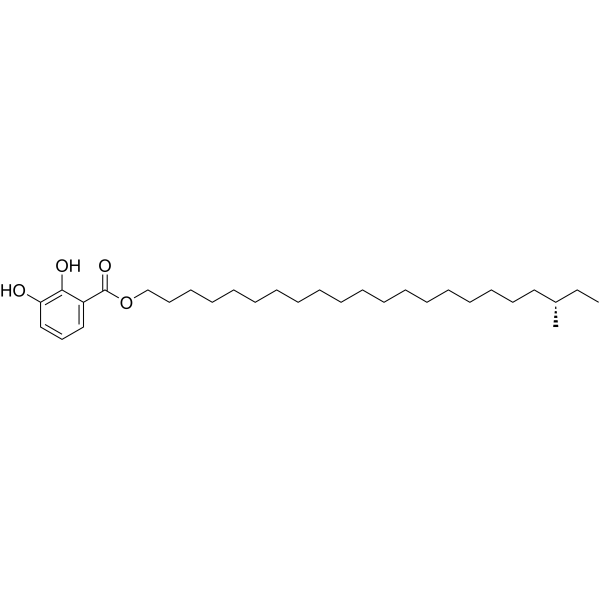
-
- HY-P5842
-
|
|
Bacterial
Influenza Virus
|
Infection
|
|
Citrullinated LL-37 3cit is a host defense peptide (HDP) with broad immunomodulatory and antimicrobial activities. Citrullinated LL-37 3cit exhibits direct antiviral effects against human rhinoviruses (HRV) .
|
-
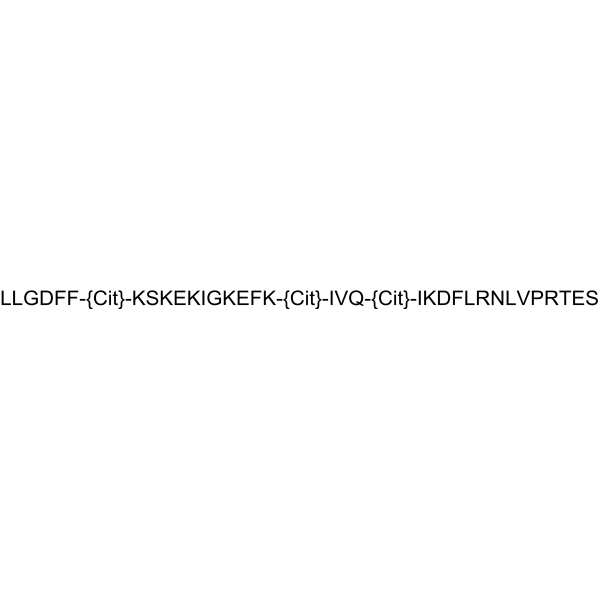
-
- HY-108964
-
|
|
Bacterial
|
Infection
Neurological Disease
Inflammation/Immunology
|
|
Carvone is a ketone monoterpene found mostly in the essential oils from plants of the genus Mentha. Carvone is widely used in the pharmaceutical industry, cosmetics and agriculture. Carvone has such effects as antimicrobial, antioxidant, anti-inflammatory, antispasmodic, antinociceptive, anticonvulsant .
|
-
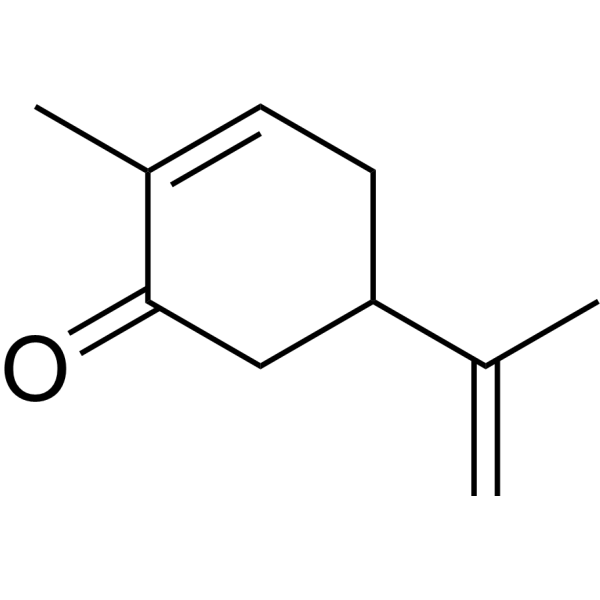
-
- HY-138247
-
|
EX-A4764; UUN51204
|
Beta-lactamase
Bacterial
Antibiotic
|
Infection
|
|
β-Lactamase-IN-2 is a beta-lactamase inhibitor, extracted from patent WO 2019075084 A1, compound 1. β-Lactamase-IN-2 has anti-microbial and anti-bacterial effects .
|
-

-
- HY-N10087
-
|
|
Bacterial
|
Infection
|
|
Angustifoline, an alkaloid, can be isolated from Lupinus angustifolius L. alkaloid extract. Angustifoline exhibits antimicrobial activity. Angustifoline could have bacteriostatic effects against S. aureus, B. subtilis, E. coli, P. aeruginosa and B. thuringiensis .
|
-

-
- HY-119500
-
|
|
HIV
Bacterial
|
Infection
Inflammation/Immunology
Cancer
|
|
Ilimaquinone, a marine sponge metabolite, displays anticancer activity via GADD153-mediated pathway. Ilimaquinone can induce vesiculation of the Golgi apparatus . Ilimaquinone exerts anti-HIV, anti-microbial, anti-inflammatory, and effects .
|
-
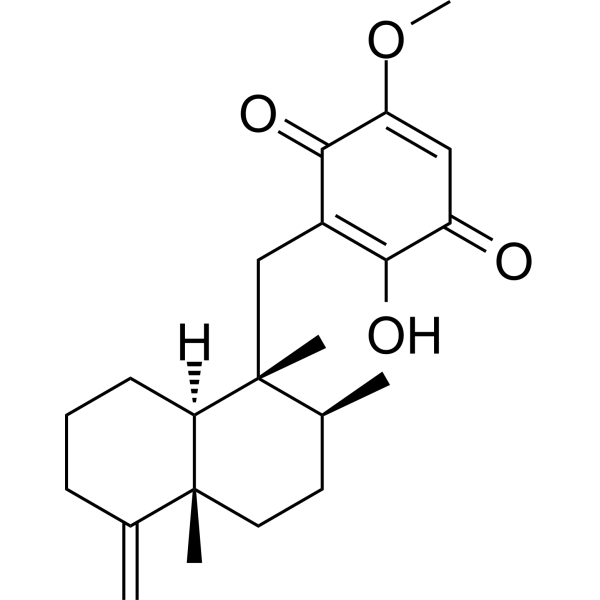
-
- HY-N10087A
-
|
|
Bacterial
|
Infection
|
|
Angustifoline hydrochloride, an alkaloid, can be isolated from Lupinus angustifolius L. alkaloid extract. Angustifoline hydrochloride exhibits antimicrobial activity. Angustifoline hydrochloride could have bacteriostatic effects against S. aureus, B. subtilis, E. coli, P. aeruginosa and B. thuringiensis .
|
-
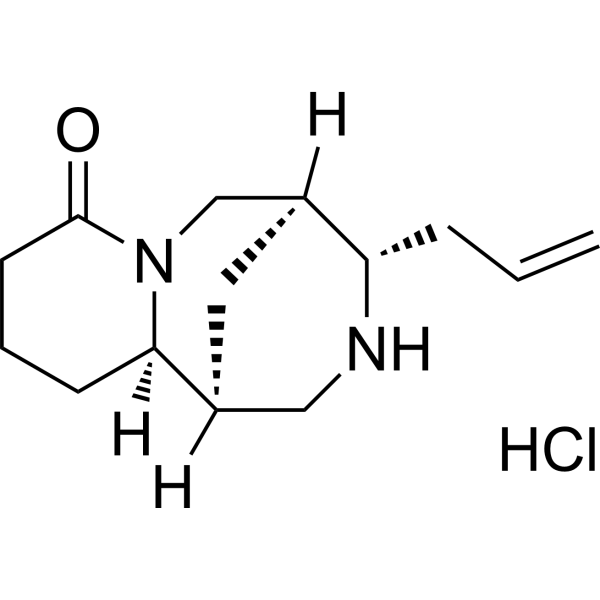
-
- HY-N3138
-
|
|
Bacterial
|
Infection
|
|
Ombuoside is a glycoside ombuoside isolated from Gynostemma pentaphyllum.Ombuoside has antimicrobial activity against several strains of gram-positive and gram-negative bacteria and the yeast Candida albicans . Ombuoside has antioxidant effects by scavenging free radicals and ROS .
|
-
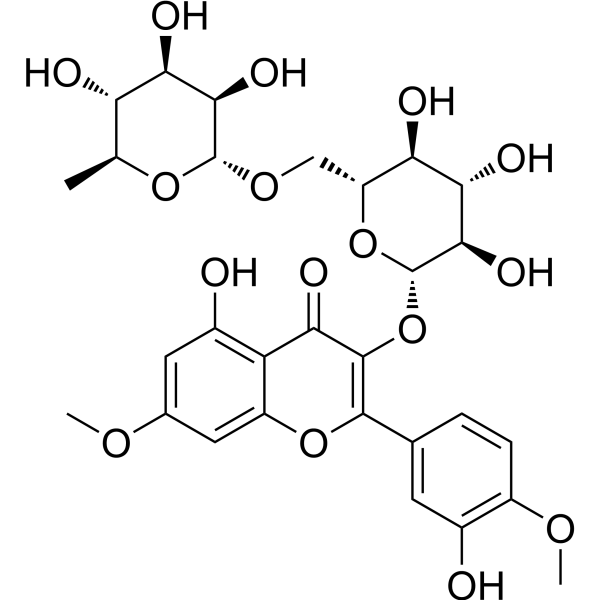
-
- HY-100435
-
|
MCB-3837; DNV3837
|
|
|
|
Oxaquin (MCB-3837) is a injectable proagent that is rapidly converted to the active substance MCB3681 in vivo following intravenous (i.v.) administration, active against Gram-positive bacterial species. Oxaquin (MCB-3837) itself has no antimicrobial effects .
|
-
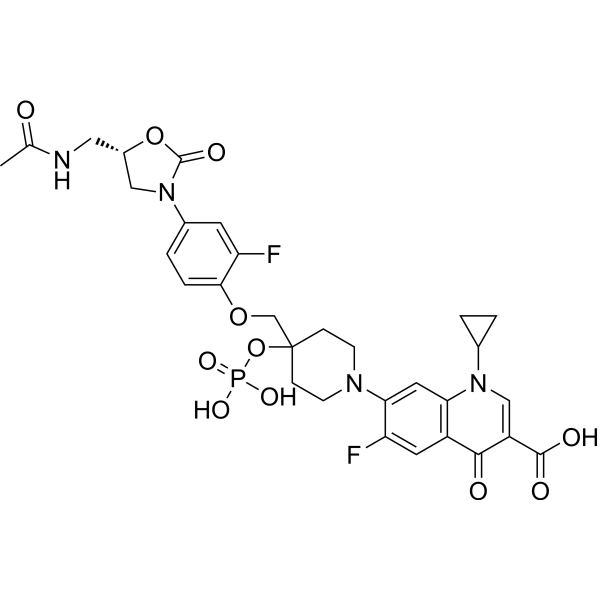
-
- HY-N6980
-
|
|
HIV
|
Infection
Cancer
|
|
Licorice glycoside C2 is a oleanane-type triterpene oligoglycoside isolated from Glycyrrhiza uralensis. Various biological activities are associated with licorice extracts, such as anti-viral, anti-microbial, antioxidant, anti-inflammatory, anti-ulcer, anti-cancer and anti-HIV effects .
|
-
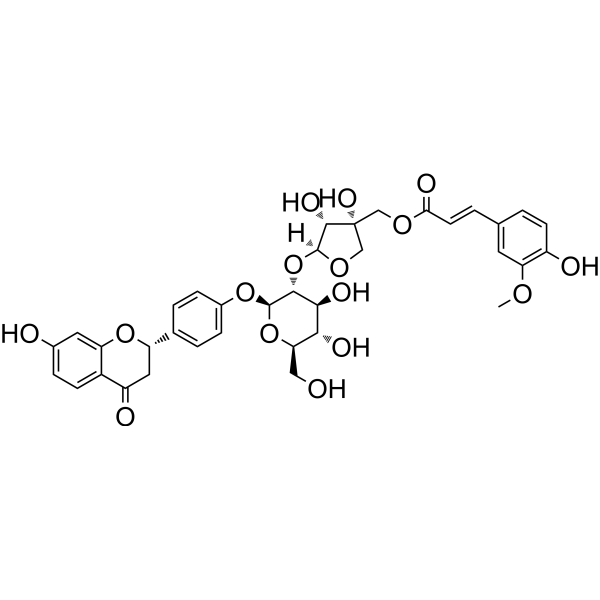
-
- HY-N9690
-
|
Longistylin A
|
Bacterial
|
Infection
Neurological Disease
|
|
Longistyline A (Longistylin A) is a natural stilbene, it can be isolated from leaves of Cajanus cajan. Longistyline A shows antimicrobial activity against MRSA with an MIC value of 1.56 μg/mL. Longistyline A shows neuroprotective effects, it can be used for the research of infection and nerve diseases .
|
-
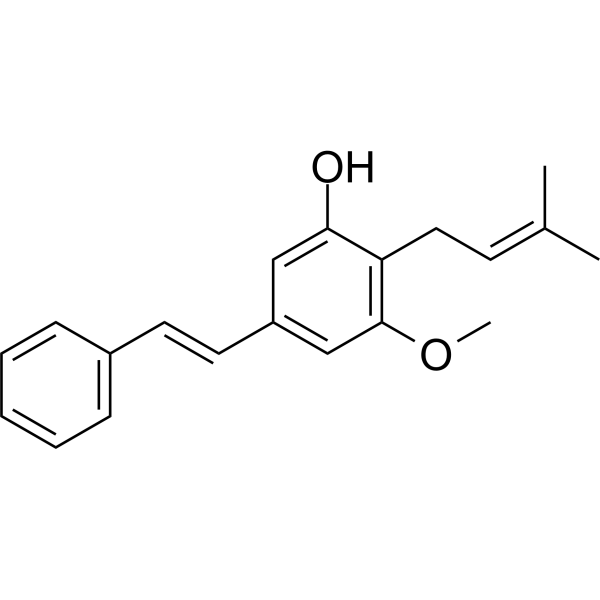
-
- HY-128525
-
|
|
Others
|
Infection
Inflammation/Immunology
|
|
Enterobactin is a bacterial siderophore that promotes iron absorption and can be used to study inflammation. Enterobactin also disrupts macrophage (MΦs) iron homeostasis and M1/M2 polarization to protect intracellular bacteria from host antimicrobial effects .
|
-

-
- HY-N2896
-
|
|
Reactive Oxygen Species
|
Inflammation/Immunology
|
|
Arjunolic acid is a saponin isolated from Cyclocarya paliurus and has various biologial activities, including antioxidant, antimicrobial, antibacterial and anti-inflammory activities. Arjunolic acid is also a potent antioxidant and plays an important role in the protection of cells and tissues against deleterious effects of reactive oxygen species .
|
-

-
- HY-150583
-
|
|
Fungal
Antibiotic
|
Inflammation/Immunology
|
|
Chitin synthase inhibitor 2 (compound 2b) is a potent inhibitor of chitin synthase with the IC50 value of 0.09 mM and the Ki value of 0.12 mM. Chitin synthase inhibitor 2 has antimicrobial activities in vitro and shows synergistic or additive effects with fluconazole or polyoxin B .
|
-

-
- HY-N3354
-
|
8-prenylgenistein
|
Apoptosis
|
Cancer
|
|
Lupiwighteone is an isoflavone present widely in wild-growing plants, with antioxidant, antimicrobial and anticancer effects. Lupiwighteone induces caspase-dependent and -independent apoptosis on human breast cancer cells via inhibiting PI3K/Akt/mTOR pathway .
|
-

-
- HY-N12617
-
|
|
Bacterial
Apoptosis
|
Infection
Cancer
|
|
Bipolaricin R (Compound 6) is a compound that can be isolated from Bipolaris maydis. Bipolaricin R exhibits noticeable antimicrobial ability against Bacillus cereus, Staphylococcus aureus, and Staphylococcus epidermidis. Bipolaricin R has excellent antiproliferation and apoptosis induction effects against A549 cell line .
|
-

-
- HY-N0346A
-
|
|
|
|
|
(E)-Ethyl p-methoxycinnamate is a natural product found in Kaempferia galangal with anti-inflammatory, anti-neoplastic and anti-microbial effects. (E)-Ethyl p-methoxycinnamate inhibits COX-1 and COX-2 in vitro with IC50s of 1.12 and 0.83 μM, respectively .
|
-
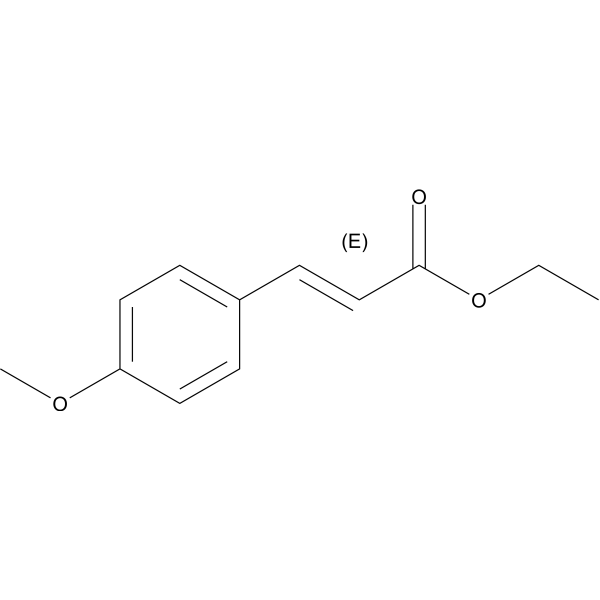
-
- HY-N0664
-
Aucubin
Maximum Cited Publications
6 Publications Verification
|
Bacterial
|
Infection
Neurological Disease
Inflammation/Immunology
Cancer
|
|
Aucubin, an iridoid glucoside, is isolated from Plantago asiatica, Eucommia ulmoides, the leaves of Aucuba japonica and more recently from butterfly larva. Aucubin has many biological activities, such as antioxidant, anti-aging, anti-inflammatory, antimicrobial, anti-fibrotic, anti-cancer, hepatoprotective, neuroprotective and osteoprotective effects .
|
-

-
- HY-B0986
-
|
4-Hexylresorcinol
|
Parasite
Bacterial
Apoptosis
Glucosidase
Endogenous Metabolite
|
Infection
Metabolic Disease
Cancer
|
|
Hexylresorcinol (4-Hexylresorcinol) is a natural compound found in plants with antimicrobial, anthelmintic, antiseptic and antitumor activities. Hexylresorcinol can induce apoptosis in squamous carcinoma cells. Hexylresorcinol is a reversible and noncompetitive inhibitor of α-glucosidase. Hexylresorcinol has protective effects against oxidative DNA damage .
|
-
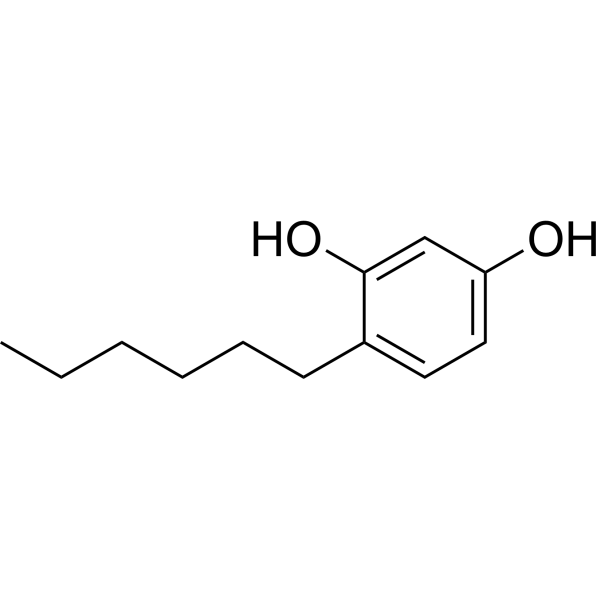
-
- HY-122267
-
-

-
- HY-B1794
-
|
|
|
|
|
Thiethylperazine, a phenothiazine derivate, is an orally active and potent dopamine D2-receptor and histamine H1-receptor antagonist. Thiethylperazine is also a selective ABCC1activator that reduces amyloid-β (Aβ) load in mice. Thiethylperazine has anti-emetic, antipsychotic and antimicrobial effects .
|
-
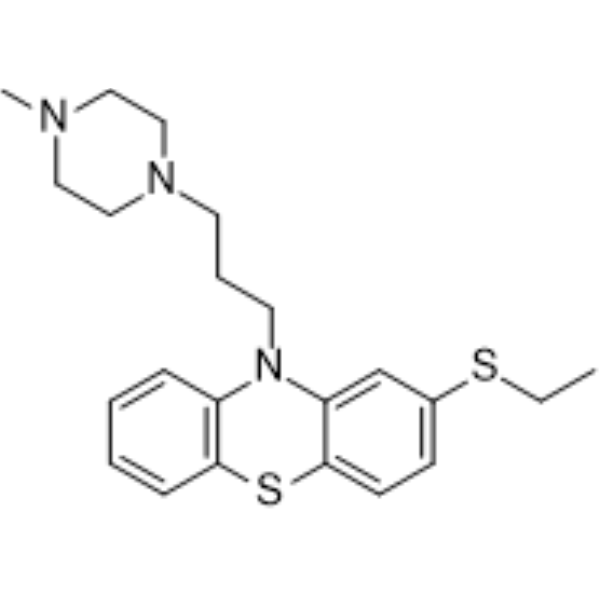
-
- HY-N0108
-
|
Parietin; Rheochrysidin
|
Bacterial
|
Infection
Inflammation/Immunology
Cancer
|
|
Physcion (Parietin) is an anthraquinone isolated from traditional Chinese medicine Radix et Rhizoma Rhei, acts as an inhibitor of 6-phosphogluconate dehydrogenase, with an IC50 and a Kd of 38.5 μM and 26.0 μM, respectively . Physcion (Parietin) exhibits laxative, hepatoprotective, anti-inflammatory, anti-microbial, anti-proliferative and anti-tumor effects .
|
-
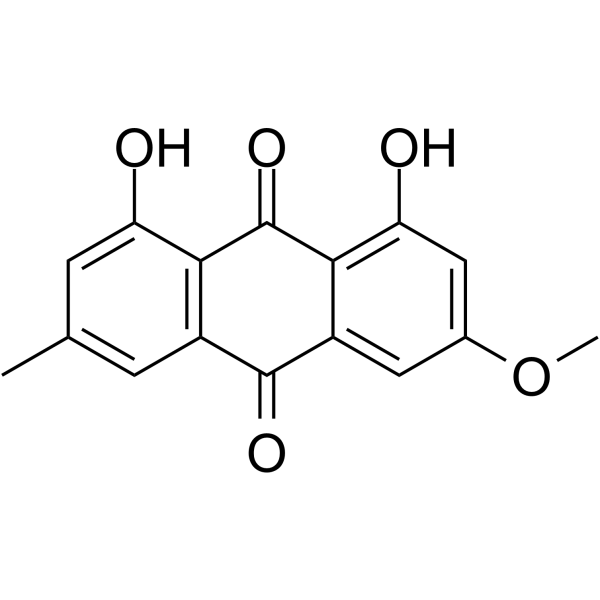
-
- HY-P1884
-
|
|
Bacterial
|
Infection
|
|
LL-37, acetylated, amidated is a cathelicidin peptide LL-37 acetylated on the N-terminus and amidated on the C-terminus. The single human cathelicidin peptide LL-37 has antimicrobial and anti-biofilm activity against multiple Gram-positive and Gram-negative human pathogens, and has wound-healing effects on the host .
|
-
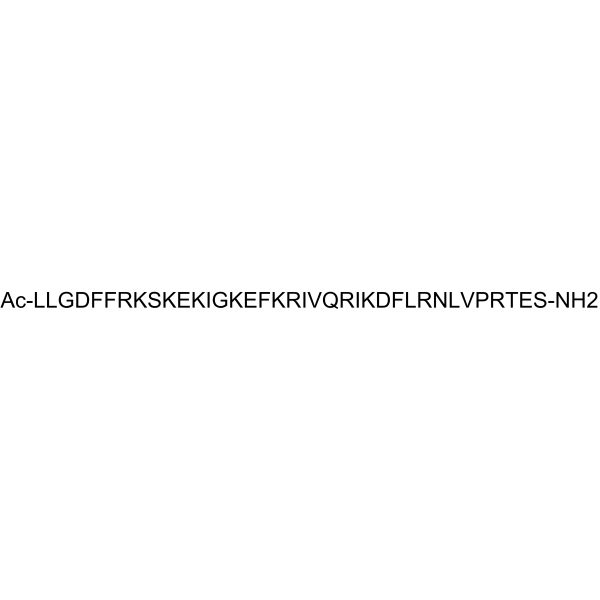
-
- HY-B1794A
-
|
|
Dopamine Receptor
Histamine Receptor
Bacterial
Amyloid-β
|
Infection
Neurological Disease
|
|
Thiethylperazine dimaleate, a phenothiazine derivate, is an orally active and potent dopamine D2-receptor and histamine H1-receptor antagonist. Thiethylperazine dimaleate is also a selective ABCC1activator that reduces amyloid-β (Aβ) load in mice. Thiethylperazine dimaleate has anti-emetic, antipsychotic and antimicrobial effects .
|
-
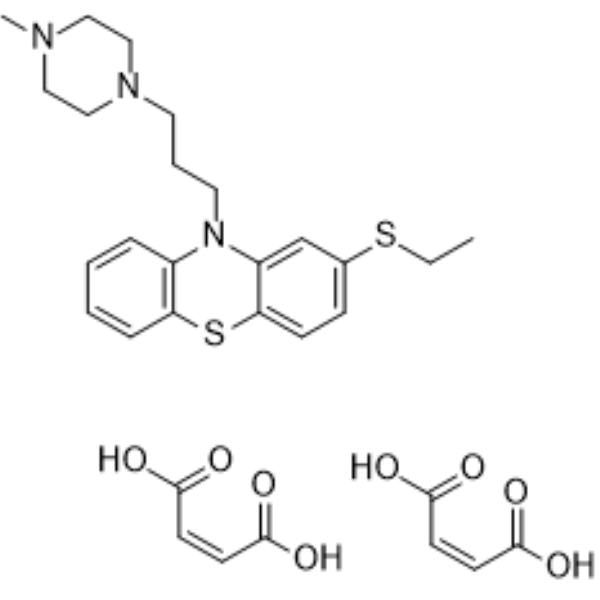
-
- HY-129555
-
|
|
Bacterial
HSV
Antibiotic
|
Infection
|
|
Surfactin is a potent cyclic lipopeptide biosurfactants consists of four isomers (Surfactin A, B, C and D), which mediates flux of mono-and divalent cations, such as calcium, across lipid bilayer membranes. Surfactin can act as an antimicrobial adjuvant with anti-bacterial, anti-fungal, antimycoplasma and hemolytic effects . Surfactin also has antiviral activity against a variety of enveloped viruses .
|
-
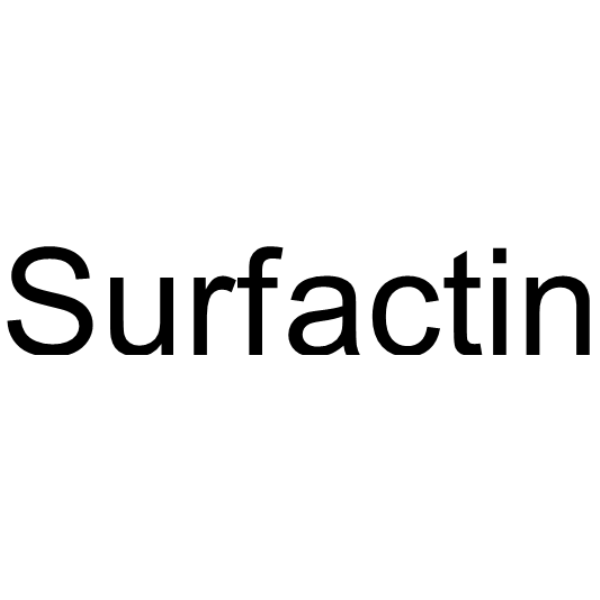
-
- HY-N0108S
-
|
Parietin-d3; Rheochrysidin-d3
|
Isotope-Labeled Compounds
Bacterial
|
Infection
Inflammation/Immunology
Cancer
|
|
Physcion-d3 (Parietin-d3) is the deuterium labeled Physcion (HY-N0108). Physcion acts as an inhibitor of 6-phosphogluconate dehydrogenase, with an IC50 and a Kd of 38.5 μM and 26.0 μM, respectively. Physcion exhibits laxative, hepatoprotective, anti-inflammatory, anti-microbial, anti-proliferative and anti-tumor effects .
|
-
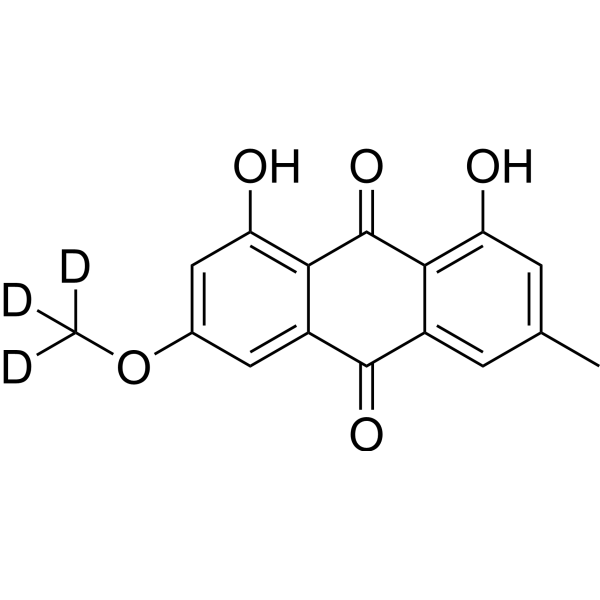
-
- HY-P0270
-
|
Magainin II
|
Bacterial
Antibiotic
Fungal
|
Infection
|
|
Magainin 2 (Magainin II) is an antimicrobial peptide (AMP) isolated from the skin of the African clawed frog Xenopus laevis. Magainin 2 displays antibiotic activity against numerous gram-negative and gram-positive bacteria. Magainin 2 also is active against protozoa . Magainin 2 exerts its cytotoxicity effects by preferential interactions with anionic phospholipids abundant in bacterial membranes .
|
-

-
- HY-P5205
-
|
|
Bacterial
|
Infection
|
|
Garvicin KS, GakA is a peptide at sizes of 34 amino acids to form bacteriocin garvicin KS (GarKS), with other 2 peptides, GakB, and GakC. Garvicin KS, GakA inhibits fibroblast viability and proliferation. Garvicin KS, GakA with GakB, is a potent combination with good peptide stability, antimicrobial efficacy, and fibroblast viability/proliferation effects. Garvicin KS peptides inhibit MSSA with MIC values in the order GakB >GakC >GakA .
|
-
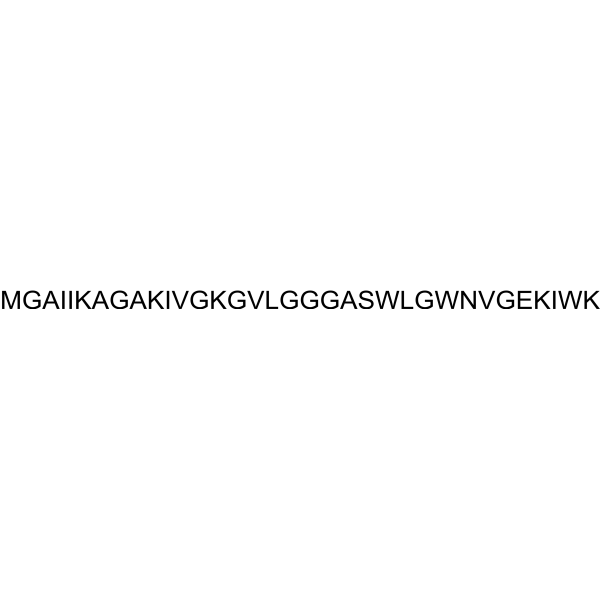
-
- HY-P5206
-
|
|
Bacterial
|
Infection
|
|
Garvicin KS, GakB is a peptide at sizes of 34 amino acids to form bacteriocin garvicin KS (GarKS), with other 2 peptides, GakA, and GakC. Garvicin KS, GakB inhibits fibroblast viability and proliferation. Garvicin KS, GakB with GakA, is a potent combination with good peptide stability, antimicrobial efficacy, and fibroblast viability/proliferation effects. Garvicin KS peptides inhibit MSSA with MIC values in the order GakB >GakC >GakA .
|
-
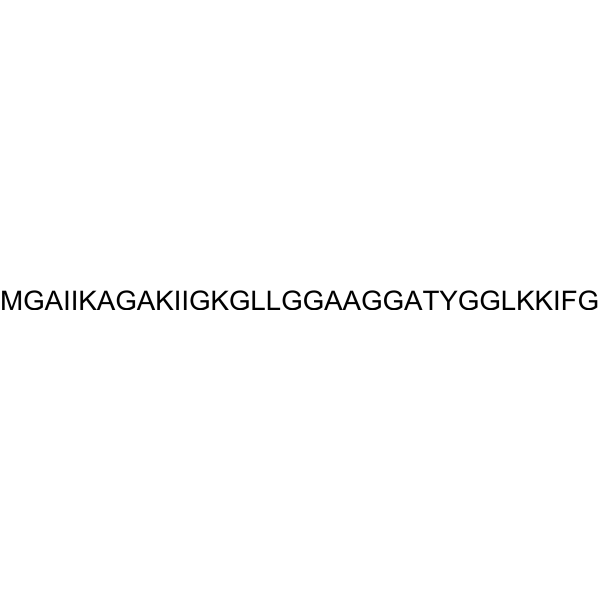
-
- HY-N6805
-
|
Acetyl isoeugenol
|
Cholinesterase (ChE)
|
Inflammation/Immunology
Cancer
|
|
Isoeugenol acetate (Acetyl isoeugenol), an essential oil constituent of nutmeg, clove, and cinnamon, shows excellent inhibitory effects against some metabolic enzymes such as acetylcholinesterase (AChE) enzymes (IC50=77 nM; Ki=16 nM), α-glycosidase (IC50=19.25 nM; Ki=21 nM), and α-amylase (IC50=411.5 nM). Isoeugenol acetate is used medical and cosmetics industries for its antioxidant, anticancer, antimicrobial and anti-inflammatory properties .
|
-
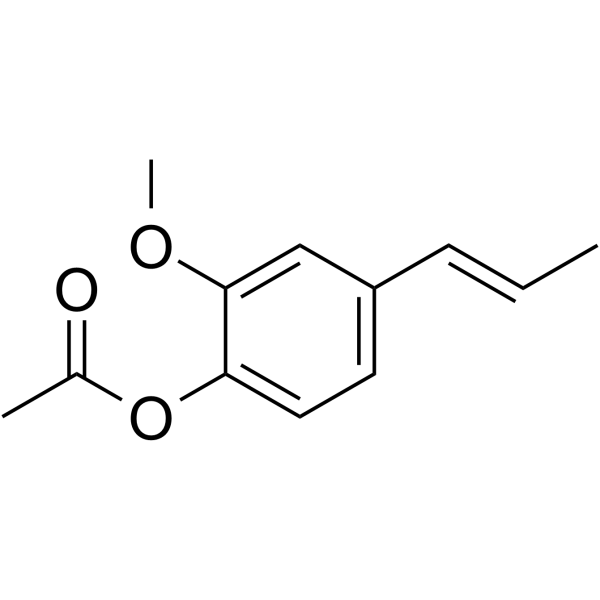
-
- HY-W099594
-
|
Benzyldimethyldodecylammonium bromide
|
Biochemical Assay Reagents
|
Others
|
|
N-Benzyl-N, N-dimethyldodecan-1-aminium bromide, also known as Benzalkonium Chloride (BAC), is a quaternary ammonium compound widely used as an antimicrobial and surfactant in various industries. BAC is commonly used as a disinfectant and antiseptic in a variety of products including hand sanitizers, disinfectant wipes and eye drops. Its ability to kill bacteria, viruses and fungi makes it an effective tool in preventing the spread of infection. BAC is also used as a preservative and disinfectant in the food industry. It is added to food packaging and processing equipment to prevent the growth of microorganisms and increase the shelf life of foods. Additionally, BACs are found in many household products such as cleaning solutions, fabric softeners and personal care products. Its surfactant properties allow it to be used to reduce surface tension and increase the effectiveness of cleaning agents. Although BAC has many uses, ingestion or exposure to high concentrations of BAC can cause skin irritation and other adverse effects.
|
-
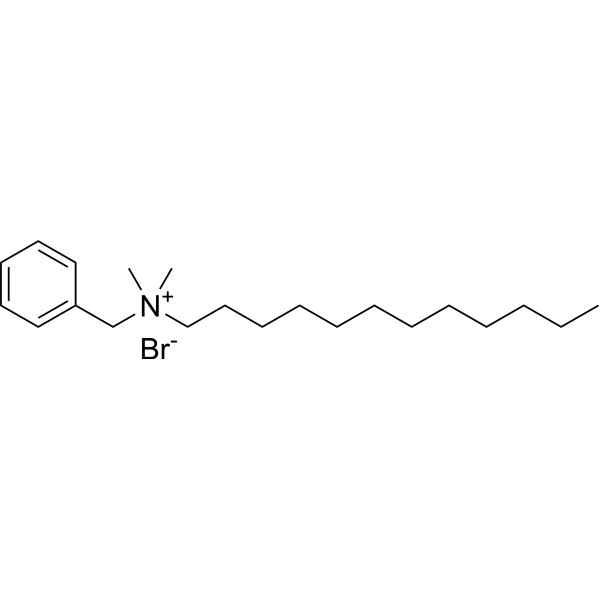
-
-
HY-L049
-
|
|
1306 compounds
|
|
Antibacterial agents are a group of materials that fight against pathogenic bacteria. Thus, by killing or reducing the metabolic activity of bacteria, their pathogenic effect in the biological environments will be minimized. The most widely used antibacterial agents exert their effects on bacterial cell wall synthesis, protein synthesis, DNA replication and metabolic pathways. However, resistance to antimicrobial agents has become a major source of morbidity and mortality worldwide. The main mechanisms of resistance are limiting uptake of a drug, modification of a drug target, inactivation of a drug, and active efflux of a drug. Therefore, it is an urgent need to develop new drugs targeted at resistant organisms.
MCE offers a unique collection of 1306 compounds with validated antibacterial activities. MCE antibacterial compound library is an effective tool for drug repurposing screening, combination screening and biological investigation.
|
| Cat. No. |
Product Name |
Type |
-
- HY-W099594
-
|
Benzyldimethyldodecylammonium bromide
|
Biochemical Assay Reagents
|
|
N-Benzyl-N, N-dimethyldodecan-1-aminium bromide, also known as Benzalkonium Chloride (BAC), is a quaternary ammonium compound widely used as an antimicrobial and surfactant in various industries. BAC is commonly used as a disinfectant and antiseptic in a variety of products including hand sanitizers, disinfectant wipes and eye drops. Its ability to kill bacteria, viruses and fungi makes it an effective tool in preventing the spread of infection. BAC is also used as a preservative and disinfectant in the food industry. It is added to food packaging and processing equipment to prevent the growth of microorganisms and increase the shelf life of foods. Additionally, BACs are found in many household products such as cleaning solutions, fabric softeners and personal care products. Its surfactant properties allow it to be used to reduce surface tension and increase the effectiveness of cleaning agents. Although BAC has many uses, ingestion or exposure to high concentrations of BAC can cause skin irritation and other adverse effects.
|
| Cat. No. |
Product Name |
Target |
Research Area |
-
- HY-P1884
-
|
|
Bacterial
|
Infection
|
|
LL-37, acetylated, amidated is a cathelicidin peptide LL-37 acetylated on the N-terminus and amidated on the C-terminus. The single human cathelicidin peptide LL-37 has antimicrobial and anti-biofilm activity against multiple Gram-positive and Gram-negative human pathogens, and has wound-healing effects on the host .
|
-
- HY-P0270
-
|
Magainin II
|
Bacterial
Antibiotic
Fungal
|
Infection
|
|
Magainin 2 (Magainin II) is an antimicrobial peptide (AMP) isolated from the skin of the African clawed frog Xenopus laevis. Magainin 2 displays antibiotic activity against numerous gram-negative and gram-positive bacteria. Magainin 2 also is active against protozoa . Magainin 2 exerts its cytotoxicity effects by preferential interactions with anionic phospholipids abundant in bacterial membranes .
|
-
- HY-P5842
-
|
|
Bacterial
Influenza Virus
|
Infection
|
|
Citrullinated LL-37 3cit is a host defense peptide (HDP) with broad immunomodulatory and antimicrobial activities. Citrullinated LL-37 3cit exhibits direct antiviral effects against human rhinoviruses (HRV) .
|
-
- HY-P5205
-
|
|
Bacterial
|
Infection
|
|
Garvicin KS, GakA is a peptide at sizes of 34 amino acids to form bacteriocin garvicin KS (GarKS), with other 2 peptides, GakB, and GakC. Garvicin KS, GakA inhibits fibroblast viability and proliferation. Garvicin KS, GakA with GakB, is a potent combination with good peptide stability, antimicrobial efficacy, and fibroblast viability/proliferation effects. Garvicin KS peptides inhibit MSSA with MIC values in the order GakB >GakC >GakA .
|
-
- HY-P5206
-
|
|
Bacterial
|
Infection
|
|
Garvicin KS, GakB is a peptide at sizes of 34 amino acids to form bacteriocin garvicin KS (GarKS), with other 2 peptides, GakA, and GakC. Garvicin KS, GakB inhibits fibroblast viability and proliferation. Garvicin KS, GakB with GakA, is a potent combination with good peptide stability, antimicrobial efficacy, and fibroblast viability/proliferation effects. Garvicin KS peptides inhibit MSSA with MIC values in the order GakB >GakC >GakA .
|
| Cat. No. |
Product Name |
Category |
Target |
Chemical Structure |
-
- HY-121362
-
-

-
- HY-105008
-
|
(S,S)-SDG; (S,S)-LGM2605
|
Cardiovascular Disease
Classification of Application Fields
Neurological Disease
Source classification
Lignans
Plants
Linum usitatissimum Linn.
Microorganisms
Linaceae
Phenols
Polyphenols
Phenylpropanoids
Disease Research Fields
|
Others
|
|
Secoisolariciresinol diglucoside ((S,S)-SDG), the main lignan in wholegrain flaxseed, is known for its beneficial effects including anti-inflammatory, antioxidant, anti-mutagenic, anti-microbial, anti-obesity, hypolipidemic, and neuroprotective effects .
|
-

-
- HY-N0570
-
-

-
- HY-N3954
-
-

-
- HY-133951
-
-

-
- HY-Y0739
-
-

-
- HY-N9096
-
-

-
- HY-108964
-
-

-
- HY-N10087
-
-

-
- HY-119500
-
-

-
- HY-N10087A
-
-

-
- HY-N3138
-
-

-
- HY-N6980
-
-

-
- HY-N9690
-
|
Longistylin A
|
Monophenols
Leguminosae
Phenols
Plants
Cajanus cajan (L.) Millsp.
|
Bacterial
|
|
Longistyline A (Longistylin A) is a natural stilbene, it can be isolated from leaves of Cajanus cajan. Longistyline A shows antimicrobial activity against MRSA with an MIC value of 1.56 μg/mL. Longistyline A shows neuroprotective effects, it can be used for the research of infection and nerve diseases .
|
-

-
- HY-128525
-
-

-
- HY-N2896
-
-

-
- HY-N3354
-
-

-
- HY-N12617
-
-

-
- HY-N0664
-
Aucubin
Maximum Cited Publications
6 Publications Verification
|
Infection
Structural Classification
Eucommia ulmoides Oliver
Iridoids
Neurological Disease
Classification of Application Fields
Terpenoids
Source classification
Eucommiaceae
Plants
Inflammation/Immunology
Disease Research Fields
|
Bacterial
|
|
Aucubin, an iridoid glucoside, is isolated from Plantago asiatica, Eucommia ulmoides, the leaves of Aucuba japonica and more recently from butterfly larva. Aucubin has many biological activities, such as antioxidant, anti-aging, anti-inflammatory, antimicrobial, anti-fibrotic, anti-cancer, hepatoprotective, neuroprotective and osteoprotective effects .
|
-

-
- HY-B0986
-
-

-
- HY-122267
-
-

-
- HY-N0108
-
-

-
- HY-129555
-
-

-
- HY-P0270
-
-

-
- HY-N6805
-
-

| Cat. No. |
Product Name |
Chemical Structure |
-
- HY-N0570S
-
|
|
|
Hydroxytyrosol-d4 is the deuterium labeled Hydroxytyrosol. Hydroxytyrosol (DOPET) is a phenolic compound drawn from the olive tree and its leaves with anti-oxidant, anti-atherogenic, anti-thrombotic, antimicrobial, anti-inflammatory and anti-tumour effects[1][2].
|
-

-
- HY-N0108S
-
|
|
|
Physcion-d3 (Parietin-d3) is the deuterium labeled Physcion (HY-N0108). Physcion acts as an inhibitor of 6-phosphogluconate dehydrogenase, with an IC50 and a Kd of 38.5 μM and 26.0 μM, respectively. Physcion exhibits laxative, hepatoprotective, anti-inflammatory, anti-microbial, anti-proliferative and anti-tumor effects .
|
-

-
- HY-N0570S1
-
|
|
|
Hydroxytyrosol-d5 is the deuterium labeled Hydroxytyrosol. Hydroxytyrosol (DOPET) is a phenolic compound drawn from the olive tree and its leaves with anti-oxidant, anti-atherogenic, anti-thrombotic, antimicrobial, anti-inflammatory and anti-tumour effects[1][2].
|
-

Your information is safe with us. * Required Fields.
Inquiry Information
- Product Name:
- Cat. No.:
- Quantity:
- MCE Japan Authorized Agent:

















































